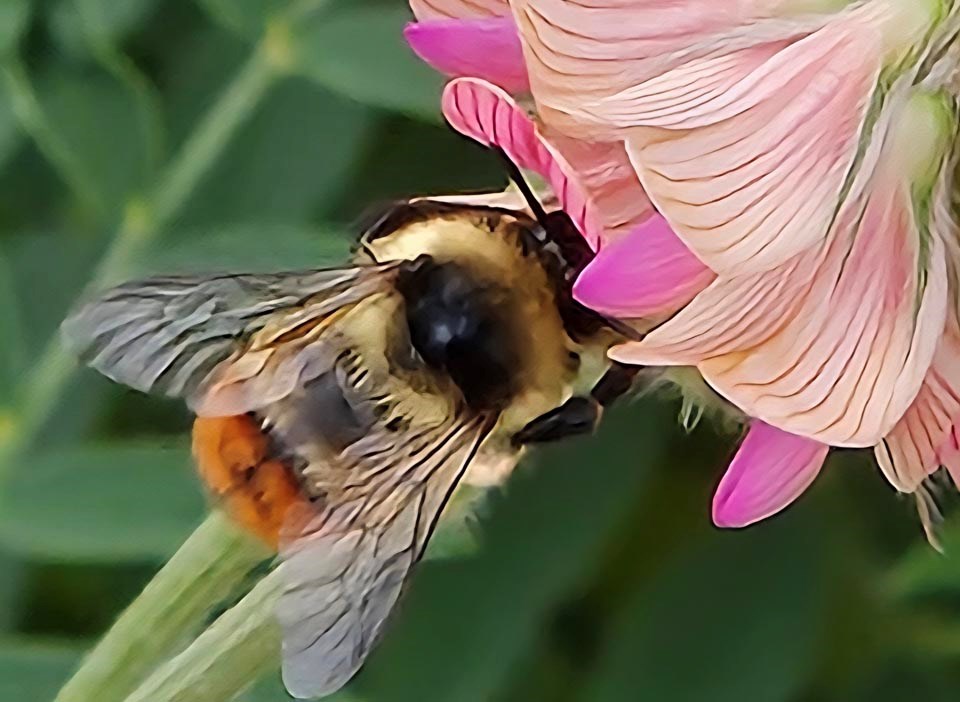There is lots of doom and gloom in the world today and one way to escape for us gardeners is to go into our yards and enjoy nature at its best. By gardening, we can make a difference in this world. Pollinators have been declining at alarming rates in recent years, and by providing habitat for these important creatures, we can turn things around.
Roughly 90 per cent of flowering plants and up to one-third of the world’s food crops depend on pollinators for reproduction and yield, respectively. With much of our native prairie converted into agriculture, the natural habitats of these important pollinators are declining. The inappropriate or overuse of pesticides by both gardeners and farmers alike has also contributed to a decline in the diversity of pollinators.
When we think about pollinators, many of us automatically think about bees, as perhaps they are the most studied. In general, bees are the workhorses for pollinating many agricultural crops in Canada. Honeybees, in particular, were imported to Canada about 400 years ago and continue to be managed for honey production and pollination purposes. Eurasian Leafcutter bees are also managed for pollination of specific crops like alfalfa. But also important are the 800 or so species of native bees from across the country that are vital for pollination, with studies showing that native bees are often superior pollinators of many crops and are often better at transferring pollen than honeybees. Many of these native bees are solitary and have relatively short foraging ranges and need good, nearby sources of water. They often nest in the ground or hollow twigs of woody or herbaceous plants and visit a wide range of flowers in search of quality nectar.
The next pollinator everyone appreciates is the butterflies and moths. Each species of butterfly has their preferred sources of flowers for nectar, and often a different host flower to deposit their eggs on, so their caterpillar offspring can feed. The most talked-about butterfly is the Monarch, which prefers milkweed (Asclepias) as a host plant and often visits Joe Pye weed (Eutrochium purpureum) as a nectar source. Providing both plants in one’s garden is more likely to attract Monarchs to your yard. In my yard, I have also seen them roosting in the spruce tree, but I am not sure if this is typical. They like an open range and prefer flowers with a large landing pad. They will eat rotten fruit and leach minerals out of damp garden soil. Other flowering plants that attract a wide range of butterfly species include bee balm (Monarda), blazing star (Liatris), yarrow (Achillea millefolium), zinnias, and sunflowers. Butterflies feed during the day, while moths feed at night and are attracted to strongly scented pale or white flowers, and especially the Evening primroses (Oenothera), which open their flowers overnight.
Beetles are important pollinators, but gardeners usually are not as enthused with them as they would rather watch out for butterflies or hummingbirds (also pollinators). Nevertheless, there are about 9000 species of beetles in Canada and they are important pollinators. Another insect that is not as appreciated is the lowly ant, which will often spread the seeds of Canadian ginger (Asarum canadense) to different parts of my yard. Then there are the wasps and finally the flies, which are active pollinators for a range of annual and perennial flowers. One genus pollinated mainly by flies is (Solidago) or goldenrods.
As gardeners, you are already providing additional habitat for pollinators by planting flowering plants that offer nectar and pollen to hungry pollinators. Some additional practices can increase their habitat in your garden. If you mulch to conserve water and suppress weeds, leave some uncovered soil in your garden where ground-nesting insects can reside. Provide water sources where insects and birds can drink without drowning; add small pebbles into bird baths, which will allow insects and bees access. You can keep some debris, like logs and tree clippings, around in a pile to create some organic shelter. Of course, avoiding the use of pesticides and herbicides will help too.
Pay attention to what is blooming at each time of the year, from spring to summer and fall. Offer a minimum of three different blooming plants at all times in your garden. Try to plant several plants of each variety, so that pollinators don’t need to relearn how to enter each bloom, as all blossoms differ somewhat. Make sure you have a mix of relatively flat flowers that provide a landing pad for butterflies, to tubular flowers that require longer tongues and provide nectar to different bees and hummingbirds. Try to include some native plants in your landscape to provide food for pollinators that originated and adapted side by side with these plants in your region.
For more information and to download your copy of ‘Selecting Plants for Pollinators’ in your ecoregion of Canada go to https://www.pollinator.org/guides the Canadian Eco Region guides are listed below the American ones featured.
This column is provided courtesy of the Saskatchewan Perennial Society
(SPS; [email protected]). Check our website (www.saskperennial.ca) or Facebook page (www.facebook.com/saskperennial) for a list of upcoming gardening events.




